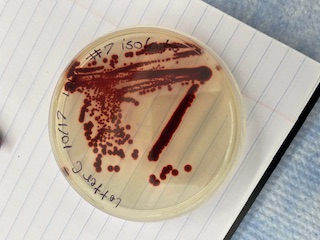Helicobacter pylori is a species of bacteria commonly found in the human stomach. H. pylori is most known for being the causative agent of stomach ulcers. Though H.pylori has the potential to become a pathogen it also has many benefical roles in regulating human stomach health. The stomach is a low PH environment so H. pylori has evoloved for those harsh conditions. One adaptation these bacteria use is to create a basic solution around themselves. They produce an enzyme called urease. Urease hydrolizes urea to form ammonia and carbonic acid. Both of these products have a high PH. This production of basic compounds can be benefical for the human host because it can decrease the chances of acid reflux and esophageal cancer.
In recent years H. pylori has been disappearing from the human stomach microbiota in western countries. There are a few reasons scientists have theroized for the disappearance. The western diet is full of processed foods and meat products treated with antibiotics. In the U.S. livestock are often fed antibiotics to promote growth. The presence of antibiotics in the meat we consume has the potential to wipe out colonies of benefical bacteria living with in our GI tract. Another possiable cause for the disappearance of H. pylori is the rates of C-sections verses vaginal births within contries. The primary way an individual is incolutated with H. pylori is from microbial transfer from mother to enfant through vaginal birth. Enfants born by C-section have microbial communities that are mainly conprised of oral and skin bacterial communities. Whereas, vaginal births usually result in an enfant with a microbiome more similar to its mothers microbiome. Rates of C-section in countries often depend on the medical infrastructure avaliable and the social trends of the time.
The disappearance of H. pylori in human stomach microbiota has lead to an increased rate of acid reflux and esophageal cancers in western countries. Weight gain and obesity have also been linked with the disappearence of the bacteria. H. pylori helps to regulate a hormone called Ghrelin. Ghrelin is responsable for telling your brain when your stomach is empty. This is your hunger response. Your body produces more Ghrelin when your stomach is empty and less when your stomach is full. In the absence of H. pylori the Ghrelin signal is muted. This can make it difficult for your brain to now if your stomach is full or empty. H. pylori is a cool microbe and its benefical roles in the human body are often understated. I will link my sources for this post below.
The Bacterium Disappearing From Our Stomachs
Relationship between Helicobacter pylori infection and GERD
the bacterium Helicobacter pylori and its role in gastritis and peptic ulcer disease
Researchers test microbe wipe to promote babies health after c-section
Helicobacter pylori infection and circulating ghrelin levels - a systematic review
How our microbes make us who we are - Rob Knight

Serratia marcescens is an anaerobic species of bacteria. It is rod-shaped and gram negative. When growing as a colony it appears red to pink in color, smooth, round, and slightly raised. What makes the colonies red is a pigment called Prodigiosin. This bacteria grows very fast. It has a doubling time of around 40-50 minutes. S. marcescens is a facultative anaerobe which means that it can survive with or without oxygen. When no oxygen is present it uses nitrite (NO2-) as its last electron accepter instead of oxygen (O2) in the ETC (electron transport chain). A unique ability this bacteria has is it can metabolize a protein called casein. This protein is present in milk, cheese and some plastics. When S. marcescens is grown on a milk agar plate it will hydrolize the casein in the milk and create a area around itself where the milk agar appears clear. S.marcescens is commonly found in peoples bathrooms or kitchens. Have you ever seen a redish to pink slime on the floor of the bathtub? That was likely some S. marcescens.
S. marcescens is usually harmless, but it is an opportunistic pathogen. This means it usuaully only infects people who have a compromised immune system. A S.marcescens infection can be serious though. S. marcescens grows very fast and is resistant to serveral kinds of antibiotics used for anaerobic infections. I haven't done much research into this but apparently some strains of S. marcescens have evolved clever tactics to evade detection from the human immune system. When the the pigment Prodigiosin is present in the human body it activates an immune response. Some S. maecescens strains have evolved temperature regulated production of Prodigiosin. At body temperature the bacteria will not produce Prodigiosin and at lower temperatures they will produce Prodigiosin. So if S. marcescens has infected a person it can more effectivly survive if it does not produce any Prodigiosin, because it will remain undetected by the immune system.
Etmologia: Serratia marcescens
Serratia marcescens - An Overview
Serratia marcescens
How and why did Serratia marcescens produce Prodigiosin?